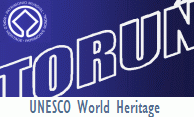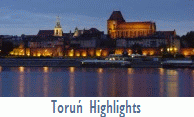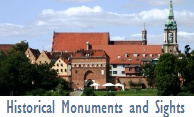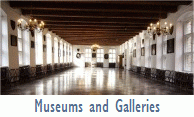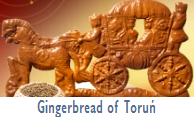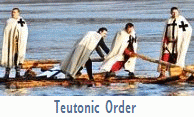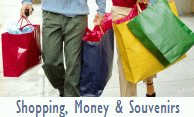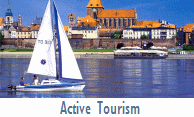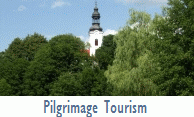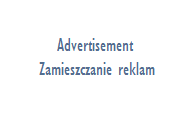|
The Eskens' House
Dom Eskenów
the museum is closed till the end of 2011 because of renovation works
High season (May - September): Tue - Sun: 11am - 6pm | Mon: closed Low season (October - April): Tue - Sun: 10am - 4pm | Mon: closed Admission fees: 7 PLN, reduced: 4 PLN Booking guides, entrance tickets, further details: Toruński Serwis Turystyczny, tel. (+48) 66 00 61 352, e-mail: muzeum@turystyka.torun.pl  • More about the edifice here
The museum consists of 2 separates departments of the District Museum: the Archaeology and the History.
The seat of the museum is the emposing house of the Renaissance Toruń's patrician family - the Eskens. As in the 19th century the house has been rebuilt nowadays the only superb Rennaisance entrance portal is the remnant of the former decoration. The richly carved sandstone portal is attributed to Willem van den Blocke - a famous Renaissance sculpture. Permanent exhibitions:
 Discovering the Past Discovering the Past The exhibition shows the culture of various peoples inhabiting or migrating as well as fighting or trading in the area close to or a bit away from Toruń. It embraces the period from the Late Palaeolihic to the early Middle Ages, i.e. from the 11 thousand BC to the half of the 13th century. By presenting the changes in architecture, the variety of tools and objects of daily use, how they evolved depending on the raw material used or innovations introduced, the attempt was made to show the changes in people`s attitudes, staring with taking the control over nature, and in time aiming at improving and making the life easier. Besides the genuine artefacts the exhibition includes models, which enable to perceive the changes taking place in the house building and settling. There is the reconstruction of a shelter (scale 1: 5) from the campsite in Mszano, from the Mesolithic. The Neolithic and the Roman period influence is represented by the fragments of huts - the first one wattle and daub construction, the other one a saddle-lath. Inside there are vessels and utensils characteristic for the particular periods. To explain the means of production and functions of numerous objects, especially the ones from the oldest periods, their models were made. The reconstructions as well as the photos of graves that show how they were equipped prove that respect for the dead was the common feature of people living both in the 11 thousand BC and in the 13th century AD Of course, the ceremonies and ways of burial differed. The most interesting exhibits certainly are face-like urns (clay vessels with relief or engraved images of the deads’ faces), characteristic for the culture of Pomerania region. The finds from burial places, images on the urns and finds from Danish peat bog made it possible to make an attempt at reconstructing attire and placing the jewellery. The characters presented at the exhibition are: a woman with jewellery from the turn of Bronze and Iron Ages, a warrior with weaponry and andorments from the 1st century BC, and a woman in attire, jewellery and objects from the Roman period. The appropriate choice of exhibits, the use of reconstructions and the logical layout make the exhibition attractive and comprehensible for the interested in the prehistory of our area. i On 18th January 1920 Toruń celebrated the comeback to Poland after the period of partitions. Apart from the science session and accompanying events, a permanent exhibition devoted to the history of Toruń from the end of the 18th century to 1920 was opened in the museum. Paradoxically, if it had not been for the fact that as a result of the Second Partition Toruń became the part of the German Kingdom of Prussia in 1793, its comeback to Poland in 1920 would not have taken place and we would not celebrate on 18th January. It is undoubtedly oversimplification, since the history of Toruń of that period was filled with, often stormy and complex, events. The alterations of borderline alone, and the fact that the town belonged to different states as a result, might confuse even experienced historians. It was twice that Toruń was in Kingdom of Prussia - from 1793 to 1806 and from 1815 to 1871, when German empire came into existence (so called 2nd Reich). There the town became automatically a strategic centre of great significance due to its location at the border wit the Russian empire. This state continued till the end of the First World War. Previously, from 1807 to 1815, it was one of the main towns of Księstwo Warszawskie (the Duchy of Warsaw). It is also worth mentioning that the First Partition moved the Prussian border several kilometers away from Toruń. The issue has been illustrated with the extensive collection of maps, and the plans of the town, which shape was strongly influenced by location (the construction of fortifications).
• Read more here. i  Militaria from the Middle Ages to 20th century Militaria from the Middle Ages to 20th centuryThe collection of weaponry consists of 600 objects of various kinds. The selected most interesting examples of both side-arms and fire-arms are on display at the permanent exhibition. The exhibition starts with swords of different types e.g. two-hand as well as execution ones, which are the oldest representatives of side-arms made of metal; then there are skewers, broad swords, and European sabers from Germany, Sweden, France, England, Russia and Poland. The exhibition presents also short side-arms such as choppers, daggers, and bayonets. Apart from side-arms there are also the most interesting representatives of fire-arms from the Museum collection. One of the most significant features distinguishing types of fire-arms is the kind of lock used in them, e.g. blasting fuse, wheel, percussion cap, or firing-pin. All types of locks, excluding the blasting fuse one, are on display at the weaponry exhibition. The most interesting exhibits presented are: a musket with a one and a half-meter-long barrel, duel pistols, a western Winchester, and Navy espingol from the 18th century. i
|
| All rights reserved Toruń 2005-2009 | About us | CenterMedia |



